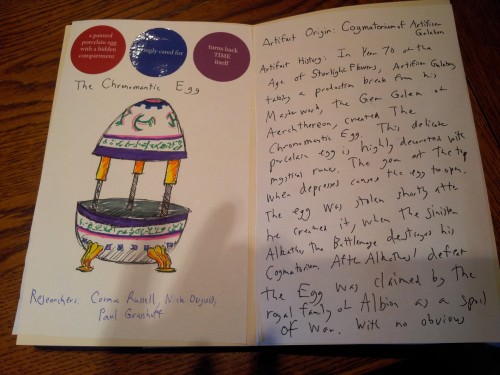I tend to be a very organized person. I like to plan. I enjoy the process of planning, and then I enjoy having everything be smooth and fun and efficient because I planned well. I’ve never had to pull an all-nighter. In college, if I stayed up all night, it was either because I had insomnia or because I was having a good time. The good time often involved playing bridge or hanging out with a cute boy. Both seemed totally worth the sleep deprivation.
I even plan when I’m not going to plan. If you plan that you’re going to be spontaneous, are you still being spontaneous? I’m not sure, but that is totally me. When I purposefully have no plan, I lower my expectations instead, and then it usually all works out very nicely. I’m also usually aware ahead of time of backup plans and which plans are super important versus which plans can be changed without it being a big deal. I don’t even do these things on purpose a lot of the time; my brain does them automatically.
Enter the Creative Process.
There are many parts of the creative process I can plan too. I can plan uninterrupted writing time. I can make daily word count goals, or scene revision goals, or what-have-you. I can make lists and notes and world building sheets. I can outline until the cows come home. I almost always know within a week or two when I’m going to finish a draft. I know what scene I’m going to write tomorrow.
But to my infinite discomfort, there are aspects of my creative process that I cannot plan. Novels, it turns out, are complicated; they consist of many interlocking parts, and sometimes the parts don’t interlock the way I think they’re going to. Sometimes either my planning or my execution is imperfect, and things aren’t set up properly the way they were supposed to be. Sometimes I come up with an idea that is ten times better than what I originally planned to do.
And sometimes ideas simply aren’t ripe. This sounds kind of woo-woo, and that annoys me, but for now, for me, it also seems to be true. Some ideas aren’t ready to go when I want them to be ready. They have pieces missing, and I can sit and think and think and think, and the pieces don’t always fall into place. And then I can’t write the rough draft because I don’t understand the novel well enough to start putting down words. I don’t know who all the POV characters are, or I don’t really understand what I’m trying to say, or I don’t have a solid structure to hang everything from, or my world doesn’t make sense yet.
And then suddenly, in its own damned time, a piece or two or three will fall into place, and the novel idea is ripe, and I can contemplate writing it and maybe even make an actual plan.
I find this both annoying and exhilarating. Annoying because I want to be able to plan further ahead, and more reliably, and I want my ideas to always cooperate with me. Exhilarating because there is nothing like that feeling when a few pieces DO fall into place, and suddenly I’ve got something where before I had nothing at all.
Anyway, I’ve been pounding my head against a novel idea for the past few months, and it wasn’t budging. So finally I turned my head to a different, older idea, and a few pieces fell into place, and maybe I’ve found my novel project for 2016. I certainly hope so.
Because I’m usually happiest when I have a plan, and I can work towards it.







